Perception of Size in Diamond Shapes Explained
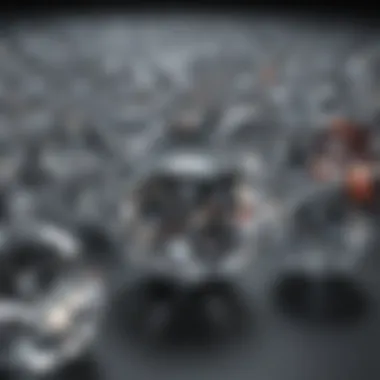
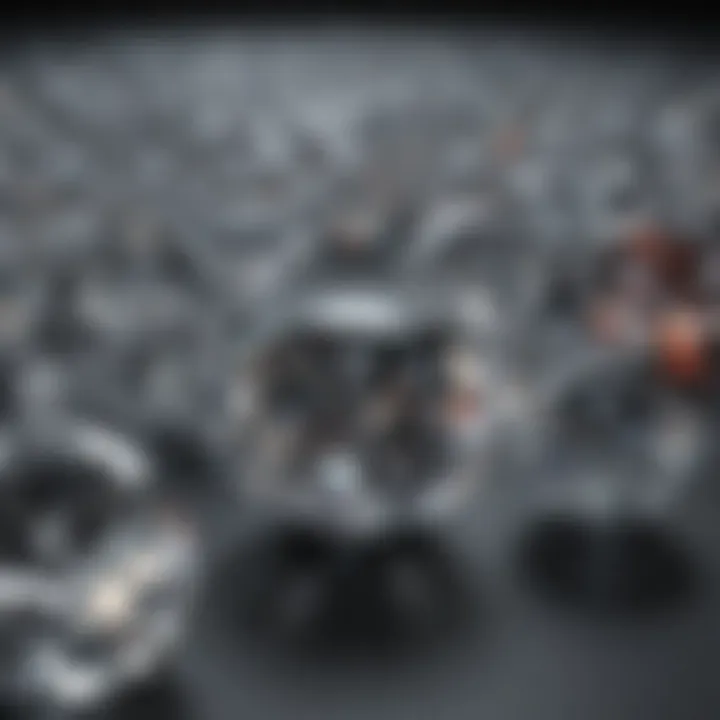
Intro
When it comes to gemstones, particularly diamonds, perception can be as compelling as reality. The sheer brilliance of a diamond often draws attention, but how size is perceived can vary wildly depending on how the stone is cut, shaped, and displayed. While many might think that size is simply a matter of measurements, the illusion of size in diamond shapes plays a significant role in the overall appeal of these gems. This section will delve into the various elements that contribute to the perception of size in diamonds and why certain cuts seem to command a more substantial visual presence than others.
Gemstone Overview
Definition and Characteristics
Diamonds are carbon crystals with a unique structure that gives them remarkable strength and brilliance. However, not all diamonds are created equal when it comes to how they look on the finger or in a setting. The characteristics that affect size perception include cut, color, clarity, and carat weight. A stone's cut, for instance, affects how light interacts with it, influencing its sparkle and thus the associated perceived size.
"The perception of diamond size is like a clever visual trick, where the right cut can make a smaller stone look larger, and vice versa."
Classification of Gemstones
Gemstones are typically classified based on their mineral composition, hardness, and the way they form. Diamonds are categorized as precious stones, often sharing this status with rubies, sapphires, and emeralds. Within the diamond category, shapes such as round, princess, and oval have distinct attributes that can dramatically alter the viewer’s perception of size. For instance, round cuts tend to maximize brilliance, often making them appear larger than they are, while fancy shapes like marquise may create an elongated appearance.
Historical Significance
Ancient Uses and Cultural Importance
Throughout history, diamonds have held significant value not only for their beauty but also for their perceived powers. In many ancient cultures, diamonds were thought to possess protective qualities and were often worn by royalty. The allure of diamonds transcended mere material worth; they became symbols of strength and resilience.
Myths and Legends Surrounding Gemstones
Various myths surround diamonds, adding a layer of intrigue to their elegance. For example, in ancient Indian culture, diamonds were associated with the divine and were believed to ward off evil. These beliefs often influenced how diamonds were presented and the settings they were placed in, further affecting their perceived size and importance.
Geometry of Diamonds and Its Impact on Size Illusion
To truly grasp the illusion of size, one must understand not just the surface but the geometry of diamonds. The cut and proportion dictate how light enters and exits the stone, playing a vital role in what a viewer ultimately perceives. Certain cuts, like the radiant or asscher, have corners and facets designed to reflect light in a way that makes them appear larger than their actual size.
Factors Influencing Visual Impact
Certain factors can enhance the illusion of size in diamond shapes:
- Setting: A well-chosen setting can make a diamond pop, creating the impression of a larger stone.
- Lighting Conditions: How light interacts with a diamond varies significantly based on the environment, influencing the stone's perceived size.
- Surrounding Stones: The presence of smaller surrounding stones can make a main diamond look bigger in comparison.
Understanding these elements can empower buyers and enthusiasts alike, enabling more informed decisions when it comes to selecting gemstones that provide the greatest visual impact. The depth of knowledge surrounding the illusion of size in diamond shapes serves to enrich the experience for anyone involved in the world of gemstones.
Prolusion to Diamond Shapes
Diamonds are not just rocks; they are complex gems that embody artistry and science in equal measure. When it comes to these precious stones, the shape of a diamond is like the very first impression in a conversation. This aspect greatly influences both its appeal and the perception of its size. Every diamond shape possesses unique characteristics that can sway preferences among buyers and collectors alike. Understanding these nuances can transform the purchasing process into a more informed and satisfying experience.
The Importance of Diamond Shape
The shape of a diamond is paramount, acting as a lens through which its beauty is perceived. Different shapes, like the round brilliant or the princess cut, offer distinct aesthetics that may resonate differently with individuals. A shape isn’t just about how it looks; it relates to how light dances within it and ultimately how we perceive its size. For instance, a well-cut round diamond often appears larger than an equally weighted emerald cut due to its extensive facets, which capture and reflect light brilliantly.
Moreover, as trends in jewelry fluctuate, some shapes rise in popularity while others fall. Keeping an eye on these shifts can help gemstone enthusiasts make aesthetic choices that not only satisfy their tastes but also offer potential investment returns.
In many cultures, specific shapes carry symbolic meanings, too. For example, a round diamond is often viewed as a classic choice for engagements, symbolizing eternity and unity. Other cuts like the heart shape might cater to a romantic narrative. With this in mind, choosing a diamond shape isn't merely a visual or financial decision; it can reflect one's identity and aspirations.
Perception of Size in Gemstones
Perception of size can be a tricky affair when it comes to gemstones. The human mind tends to play tricks, creating an illusion of size that may not correspond with the actual measurements. Factors like cut, shape, and the way the diamond is set can all skew perception significantly.
- Cut Quality: A well-executed cut can make a diamond appear larger than it is. The right proportions and angles optimize light reflection, contributing to an expanded visual representation.
- Shape Matters: Some shapes, such as the oval or marquise, may deceive the eye into believing they occupy more area than they actually do, whereas others, like the asscher cut, might look more compact.
- Setting: The way a diamond is placed within its setting can enhance its perceived size. A halo setting, for instance, surrounds the diamond with smaller stones, creating an illusion of greater size and brilliance.
Many buyers, particularly those new to the diamond market, may not consider these subtle distinctions, potentially leading to a purchase that doesn't fulfill their expectations. Understanding how perception operates in the gemstone world is crucial for anyone keen on making smart choices when purchasing diamonds.
"Understanding the illusion of size is just as important as understanding the stone itself. A diamond's shape does not merely define its beauty but also impacts how we appreciate its value and significance."
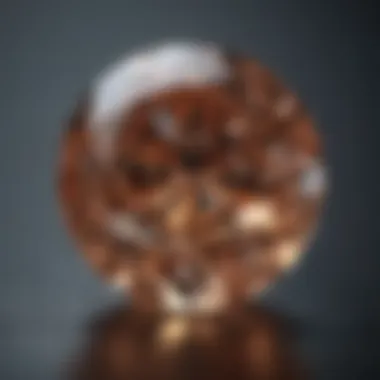
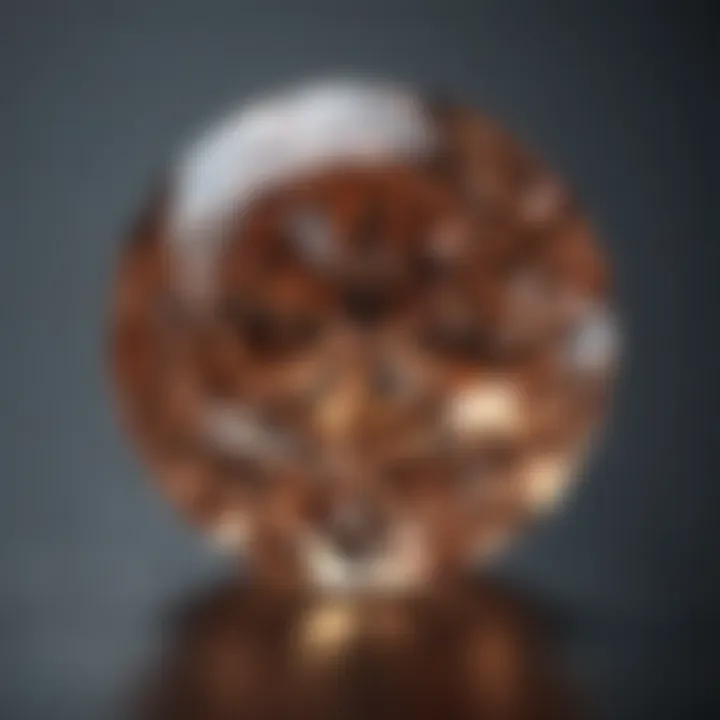
By grasping these aspects of diamond shapes, enthusiasts and collectors stand to gain a profound edge, transforming the act of selecting a stone into an art, rooted in knowledge and personal preference.
Common Diamond Shapes and Their Characteristics
Understanding the various diamond shapes is crucial for anyone involved in the gemstone industry or for those who simply appreciate the beauty of diamonds. Each shape has its unique traits that not only reflect light differently but also influence how size is perceived by the eye. This section unfolds the distinct characteristics of common diamond shapes, providing insight for collectors, jewelry designers, and enthusiasts alike.
Round Brilliant Cut
The Round Brilliant Cut is perhaps the most recognized and popular diamond shape. With 58 facets, this cut is designed to maximize light return, making it sparkle like none other. The circular symmetry aids in the illusion of size, as the light reflecting from its numerous facets creates a bold appearance.
Many people feel that the round shape looks slightly larger than other shapes with the same carat weight. This perceptual phenomenon is due to its proportions and the way it captures and reflects light. Its brilliance can often overshadow its actual size, drawing the eye toward its sparkling surface instead.
Princess Cut
In recent years, the Princess Cut has gained significant popularity, often being seen as the modern alternative to the Round Cut. Characterized by its square shape with pointed corners, it brings a contemporary flair while still maintaining substantial brilliance.
The arrangement of facets in the Princess Cut is designed to optimize light performance, which can enhance its size perception. However, compared to the Round Cut, it may exhibit different visual dimensions due to its angular shape. As such, it might look smaller than a Round Cut of the same carat weight despite having a larger diamond surface area.
Emerald Cut
The Emerald Cut is a rectangular shape with step-like facets that create a unique optical appearance. This cut is famed for its elegance and clarity, but it doesn't have the same level of brightness seen in the Round or Princess Cuts. Instead, it emphasizes clarity and hue, showcasing the diamond’s internal characteristics.
One interesting aspect of the Emerald Cut is that its elongated facets can create an illusion of a larger size. The broader table surface gives it a more generous visual profile, which can trick the eye into perceiving it as bigger than other cuts of similar weight.
Asscher Cut
Similar to the Emerald Cut but square in shape, the Asscher Cut has gained a devoted following among vintage diamond enthusiasts. Its deep facets and unique table enhance the visibility of light and shade, giving it a sophisticated charm.
The Asscher Cut can also appear larger due to its wide facets, which are specifically designed to optimize their interplay with light. This means that even if the carat weight is lower, it can give that impression of impressive size.
Cushion Cut
Known for its romantic appeal, the Cushion Cut combines a square and round shape, often referred to as a “pillow” shape. This cut is particularly adept at playing with light and can vary immensely in appearance due to its facet configuration and size.
While its soft corners provide a delicate touch, the Cushion Cut can also be impacted by the way light is reflected off its facets, often appearing larger than it is. The allure of a Cushion Cut can attract attention, making it a popular choice for engagement rings.
Other Notable Shapes
Beyond the commonly discussed cuts, several other shapes warrant attention for their unique attributes and appeal. Shapes like the Oval Cut, Marquise Cut, and Radiant Cut each offer distinct characteristics that can also influence size perception.
- Oval Cut: This shape can elongate the look of the finger, creating a size illusion that many find appealing.
- Marquise Cut: With its elongated silhouette, it provides the image of greater size without the need for higher carat weights.
- Radiant Cut: Combining the rounded corners of a cushion with the brilliance of a round cut, it balances size perception and sparkle elegantly.
These diverse shapes make it clear that the characteristics of diamonds are not just about the cut itself but also how they come together to form the visual impact seen by onlookers.
Understanding these common diamond shapes, alongside their individual visual cues, empowers buyers and enthusiasts to make more informed choices.
How Diamond Cut Influences Perceived Size
The cut of a diamond serves as a cornerstone in the narrative of its size perception. It is not just about how the gem appears on the outside; it’s about the intricate dance of light and shadow that happens within. A well-cut diamond manages to coax out its inherent beauty while also creating a larger-than-life illusion. This section dives into how the specific cut can alter the size perception of a diamond, emphasizing that the nuances of geometry play a pivotal role.
The Role of Proportions
When it comes to diamonds, proportions can make or break how a stone looks. If the length to width ratio is off—even just a smidgen—the stone might look smaller or oddly shaped. For instance, a classic round brilliant cut has an ideal ratio that maximizes sparkle and visual size, while an overly shallow or deep cut can lead to a substantial loss of brilliance.
In a sentimental act, consider the round brilliant cut. This design typically achieves stunning light dispersion. The average person perceives this kind of cut as larger. Alternatively, shapes like the princess or cushion require careful attention to proportions to convey the same visual heft. An ideal ratio makes these diamonds appear more substantial without actually adding weight.
Features like girdle thickness—a term that refers to the diamond's widest point—also play a role. A thicker girdle can decrease the visible size, making the stone seem smaller than its actual carat weight. Understanding these nuances can help buyers choose wisely.
Facet Arrangement and Light Reflection
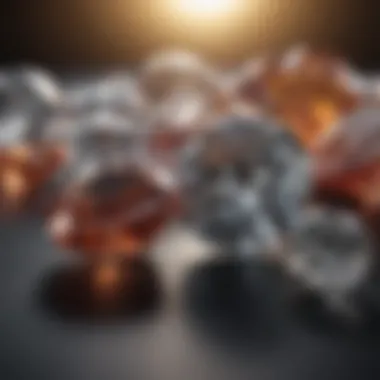
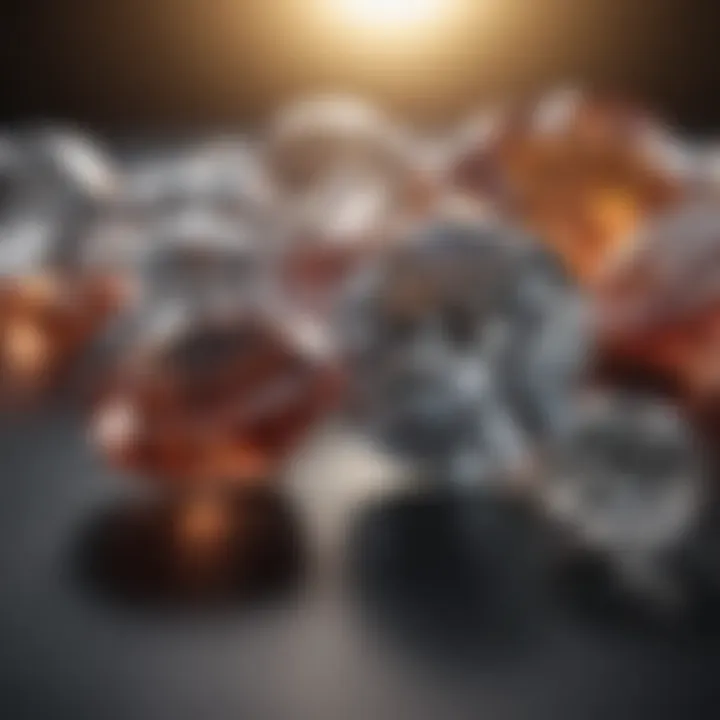
Facet layout is where the magic happens; light interacts with a diamond in ways that can boggle the mind. The arrangement of these facets dictates how light is reflected and refracted, projecting size perception to viewers.
When facets are well-placed, like in a round brilliant cut, they can bounce light beautifully, maximizing the size appearance. Alternatively, a poorly arranged facet pattern can mute the sparkle, making the diamond seem less appealing in terms of visual size.
Light reflection often varies with the diamond shape. Take, for instance, an emerald cut. This step-cut style emphasizes clarity but may not project sparkle the same way a round cut does. As a result, it may appear less substantial, despite having identical carat weight compared to a round gem.
"The brilliance of a diamond lies not only in its physical size but also in how light embraces it."
In summary, the diamond cut can significantly manipulate how we perceive size. Each element—from proportions to facet arrangement—plays a defining role in revealing beauty and enhancing perceived size. Gaining insight into these factors can profoundly impact decision-making for collectors and enthusiasts, helping them to appreciate both the artistic and mathematical elements behind diamond design.
Setting Styles and Their Impact
When it comes to diamonds, the setting style can significantly enhance or diminish the visual size of the stone. This might seem like a small detail, but it's akin to dressing for an occasion; the setting acts as the outfit that either complements or overshadows the diamond within. A well-chosen setting can project an impression of size that goes beyond the carat weight of the gem itself. Let's delve into the specifics of setting styles and uncover how they can alter the perception of size in diamond shapes.
Types of Settings
Various styles of settings cater to different tastes and aesthetics, each bringing its unique flair. Here’s a closer look:
- Prong Setting: This is one of the most classic settings, designed to lift the diamond closer to light, maximizing sparkle. With typically four to six prongs, this setting allows for substantial exposure of the diamond, which can give it a larger appearance due to the way light reflects off its facets.
- Bezel Setting: In this style, the diamond is surrounded by a metal rim. While it often secures the stone well, it may mask some size, as the gem sits lower and appears more contained. However, some prefer this for its sleek and modern aesthetic.
- Halo Setting: This involves a circle of smaller diamonds around a center stone, providing a stunning contrast that makes the center stone appear larger. A halo can create a dramatic effect, making what might be a modest-sized diamond look larger than life.
- Channel Setting: Here, smaller diamonds are set in a channel of metal, often along the band. While the emphasis is on the row of diamonds rather than the central stone, these designs can create a cohesive, full look that makes the entire ring appear larger.
Each type of setting carries its pros and cons, affecting not just the aesthetics but how size is perceived. Choosing the right one is a crucial step in maximizing the visual impact of your diamond.
Height and Visibility
The way a diamond is set can dramatically change how it is seen. Height plays a pivotal role in this regard. A diamond set high above the band takes on a more commanding presence, catching the eye and allowing more light to reach it. This exposure often leads to a perception of a larger size. Conversely, a lower-set diamond often blends in with its band, sometimes giving off a compact feel that may not highlight the size effectively.
Additionally, consider how visibility connects with lifestyle. If someone leads an active lifestyle, low-set designs may be preferable for practicality, even though they might not emphasize the diamond's size as much.
According to industry experts, the height of a diamond can be a critical factor in how it registers visually. A higher setting can create a perception of a larger stone, despite the actual carat weight.
Color and Clarity Considerations
When diving into the enchanting world of diamonds, two elements stand out significantly: color and clarity. These attributes not only define the aesthetic quality of a diamond but also play a crucial role in shaping the perception of size. Understanding how these components interact gives collectors and enthusiasts a richer perspective on what to look for when selecting a gemstone.
Impact of Color on Perceived Size
Color can dramatically influence how a diamond is viewed. From the moment one lays eyes on a diamond, the first impression often hinges on its hue. For instance, a diamond that boasts a colorless appearance tends to project an optical space, making it appear larger than it actually is. In contrast, diamonds with more noticeable color can create a visual density that might trick the eye into perceiving a smaller size.
A fantastic example is the difference between colorless diamonds graded as D through F and those in the G to J range. The former group reflects light more effectively due to less absorption of colored wavelengths, which not only intensifies sparkle but also enhances perceived size.
Ultimately, it involves the colors interacting with the surrounding environment. Choosing the right setting can minimize or amplify these effects.
"The clarity and color of a diamond make it not just a precious stone but an artistic masterpiece that speaks volumes of its identity."
Clarity and Its Visual Effects
Clarity relates to the internal and external imperfections, often referred to as inclusions or blemishes. These minor flaws can affect not just the diamond’s beauty but also how size is perceived. A diamond with high clarity typically appears more brilliant and vibrant. In fact, when you have clarity at a higher scale—like a VVS1 grade—the light enters and exits the stone without interruption, projecting a larger dimension in terms of visual impact.
Conversely, lower clarity ratings can introduce shadows and distractions that may impact how big the diamond looks. For example, a diamond that features a visible inclusion might draw the viewer's eye to that flaw, which can make the entire stone appear less significant.
In a nutshell, while the size alone might catch the eye initially, a diamond’s color and clarity complement the overall visual narrative—each facet engaging in dialogue with the other. This dialogue ultimately shapes the way one perceives size, adding layers to the experience of choosing the perfect diamond.
Lighting Conditions and Their Effect
The role of lighting can’t just be glanced over when discussing the perception of size in diamond shapes. Just like how an artist’s canvas can change based on where the light hits it, diamonds also react differently to varying light conditions. Understanding how light interacts with a diamond can not only enhance its beauty but can drastically change how big or small it looks. When shopping for a diamond, recognizing the importance of light conditions is key to making the right choice.
Natural Light Versus Artificial Light
When we talk about light, the first big distinction we need to make is between natural light and artificial light. Natural light, such as sunlight, provides a full spectrum of colors and can showcase a diamond's brilliance and fire, which refers to the colorful sparkles that occur when light is reflected.
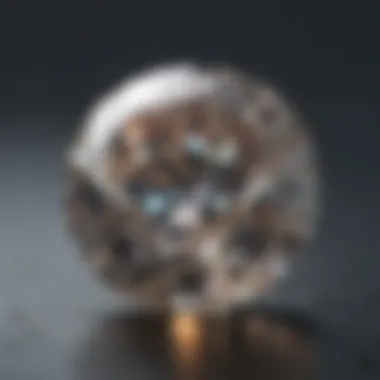
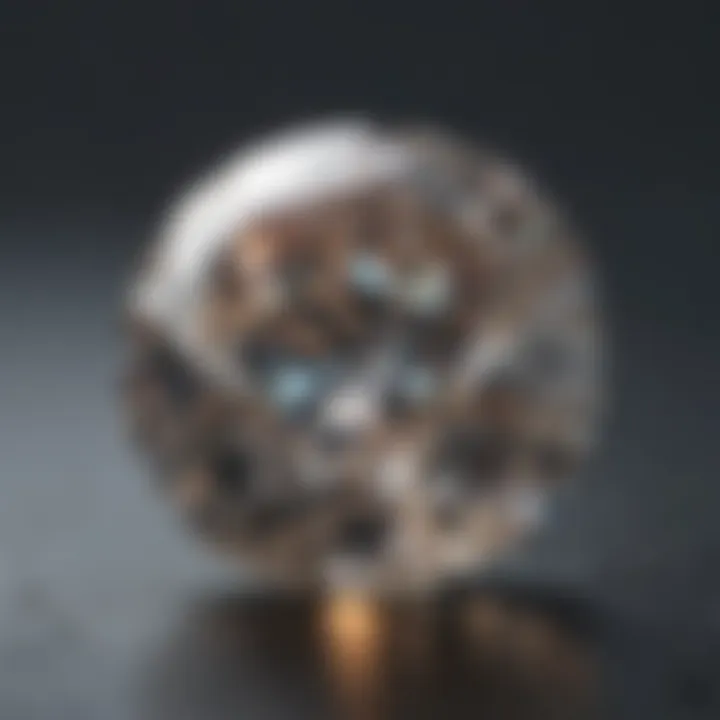
- Brightness: Diamonds tend to sparkle more in natural light. Colors become more vivid, and any inclusions that might make the diamond look smaller are less noticeable.
- Time of Day: The position of the sun changes throughout the day, affecting the quality of the light. Diamonds can look much larger and more radiant around midday when sun rays are direct compared to early morning or late evening.
On the flip side, artificial light, depending on its source, can often wash out the diamond’s colors. Fluorescent lights for instance might create a flat appearance.
- Type of Bulb: Incandescent bulbs can highlight brilliance but may reduce perceived size due to shadows created.
- Color Temperature: A bulb’s color temperature can influence how a diamond looks. Warmer tones intensify color while cooler tones can enhance clarity.
Overall, understanding these factors aids not just jewelers but consumers as well in getting the most out of their gemstone. This knowledge could easily tip the scales when one is deciding between two diamonds that appear similar in size.
Light Direction and Angle
The lights direction and angle are major players in size perception too. It’s not just about the type of light; it's also about where it’s coming from. The way light hits a diamond can change the visual effects it has on the viewer’s eyes.
- Top Lighting: When light hits directly from above, it tends to make the diamond look more substantial. This occurs because the light penetrates the stone and reflects back outward, showcasing its facets and thus enhancing its overall presence.
- Side Lighting: When viewed in sidelighting, a diamond can appear smaller. The face of the diamond may seem less bright, leading to an impression of a flatter surface.
- Angles: The angle at which one views the diamond also alters its perceived size. A diamond held at a strange angle may seem elongated or distorted, tricking the eye and perception completely.
"The beauty of any gemstone lies in the dance between light and the stone itself; perfecting that dance can lead to a mesmerizing result."
In summary, controlling for lighting conditions can significantly aid in making a diamond appear larger or smaller. Jewelers often employ strategic lighting to highlight the diamond’s dimensions while consumers should take note of lighting conditions when selecting their perfect stone. Consciousness about how light interacts with different diamond shapes is crucial for those looking to maximize their visual impact.
Psychological Factors in Size Perception
Perception of size in diamonds isn't solely about their physical dimensions; it also involves an intricate dance of psychological factors. How individuals perceive the size of a diamond can, in many ways, be more potent than the actual measurements of the stone. Understanding these psychological elements helps in both choosing the right gemstone and appreciating the art of jewel crafting. It's vital to delve into cognitive biases and cultural influences, as these shape our preferences and expectations around diamond sizes.
Cognitive Biases
Cognitive biases are mental shortcuts or preconceived notions that influence how we interpret information. In the realm of diamonds, several biases can skew perceptions. Here are a few that particularly resonate:
- Anchoring Bias: We often anchor our opinions on the first piece of information we see or hear. For instance, if someone is previously shown a large diamond and then shown a smaller one, they might perceive the latter as significantly smaller, even if its actual size is relatively substantial.
- Size Contrast: This bias dictates that we judge size relative to surrounding objects. If a diamond is placed beside a larger gemstone, it may seem diminutive regardless of its true dimensions. This context can dramatically alter our perceptions.
- Scarcity Heuristic: When individuals perceive a diamond as rare, they may regard it as more valuable or larger. This bias leads many to believe that less common shapes or sizes carry more weight—or, a deeper significance—than what is on the scale.
"What we see isn't always the whole picture; sometimes, it's about how we feel about what we see."
Cultural Influences on Size Preference
Culture has a powerful role in shaping our preferences, including what we deem attractive or desirable in diamonds. Size can mean different things across various societies. For example, in some cultures, a large stone may symbolize prosperity and success, whereas, in others, a modest yet exquisitely cut diamond may be perceived as more sophisticated.
Consider the following:
- In Western cultures, larger diamonds often signify wealth and status. A sizable engagement ring may be a status display, implying security and success in life.
- In contrast, in many Asian cultures, the brilliance and craftsmanship of the diamond takes center stage over sheer size. A well-cut but smaller diamond can outshine a larger, poorly cut one in these contexts.
In examining these elements, it becomes apparent that psychology and culture play a crucial role in diamond buying. Diamond enthusiasts and collectors must navigate these perceptions skillfully, understanding how psychology can impact what they seek in a stone. Recognizing these factors not only enriches the buying experience but also encourages a deeper appreciation for the artistry involved in diamond design and selection.
Closure: Making an Informed Choice
In the realm of diamonds, understanding perception is key to making an informed choice. The illusion of size can heavily influence not just the aesthetics of a piece but also its value and desirability. Grasping how different factors interplay can empower buyers. It's more than simply picking a stone that sparkles; it's about selecting one that fulfills personal criteria for beauty and significance.
When navigating the diverse landscape of diamond options, consider the following elements:
- Gemstone Shape: Certain cuts, such as the cushion cut or princess cut, tend to maximize perceived size due to their geometric properties. Buyers should look at how each shape interacts with light and how it visually appears on the finger.
- Proportions and Depth: The proportion of a diamond should not be overlooked. Sometimes, a deeper stone may appear smaller than a well-proportioned one. Paying attention to these details can help in selecting a more visually impactful option.
- Setting: The choice of mounting can alter how a diamond is perceived. Elevating the setting or opting for a halo design can create an illusion of a larger size, enhancing the visual presentation.
- Color and Clarity: These factors affect not just appearance but also overall enjoyment of the piece. A stone that exhibits vibrant color can draw the eye, making it appear larger, whereas clarity impacts brilliance and light reflection.
The benefits of understanding these nuances cannot be understated. Equipped with knowledge, buyers can confidently choose diamonds that resonate with their personal taste while ensuring they make a sound investment.
"Knowledge is the bridge between desire and fulfillment, especially in the delicate world of gemstones."
Evaluating Your Options
Evaluating your diamond options is a meticulous process that should go beyond just emotional appeal. First and foremost, take a step back and analyze.
- Research: Familiarize yourself with various diamond shapes and their unique properties. Each cut, from the round brilliant to the emerald cut, has distinct facets that influence light performance and size perception.
- Seek Expert Advice: Engaging with knowledgeable jewelers or gemstone experts can provide insights that typical advertisements may not offer. Their experience can guide you toward selections that align with your preferences and requirements.
- Consider Your Lifestyle: Ask yourself where you will be wearing the piece. A more delicate design may be suitable for daily wear, while a bolder structure might suit special occasions.
Taking time to evaluate options can result in a more satisfying purchase that appeals to both heart and practicality, crafting a meaningful connection with the stone you choose.
Final Thoughts
To wrap this discussion, remember that the decision-making process when it comes to diamonds is multi-faceted. This article aimed to demystify the illusions surrounding size perception in diamond shapes, highlighting how these elements align with making a judicious choice.
Ultimately, the right diamond for you is one that resonates with your taste, meets your functional needs, and gives you that spark of joy whenever you see it. Don’t rush the process. The beauty of diamonds is in their individuality—take the time to find what fits your vision perfectly, whether it's a sparkling round brilliant or a vintage asscher cut.
Your choice of diamond isn't just about size; it's about the story it tells, the memories it captures, and the beauty it brings into your life.







